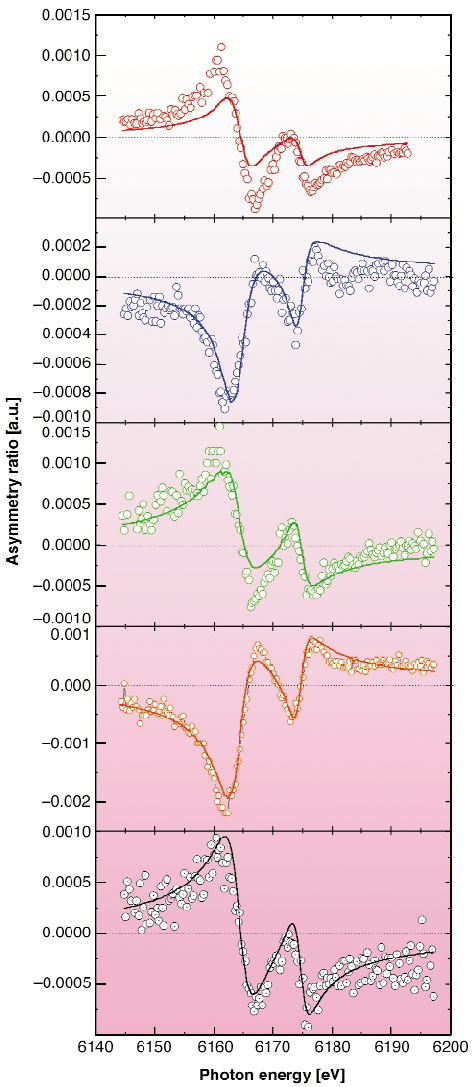- Home
- Users & Science
- Scientific Documentation
- ESRF Highlights
- ESRF Highlights 2003
- X-ray Absorption and Magnetic Scattering
- Magnetic Profilometry in Multilayers
Magnetic Profilometry in Multilayers
Although X-ray reflectivity specular or off-specular diffuse scattering have been widely applied during the last decade to characterise the morphology of nano-structured materials, it is only recently that progress in synchrotron radiation instrumentation allows an increasing use of X-ray resonant magnetic reflectivity experiments. The strength of this approach is to combine the shell magnetic sensibility of the X-ray magnetic circular dichroism and the spatial sensitivity of the Diffracted Anomalous Near Edge Spectroscopy (DANES). A promising application is the study of interfacial effects in nano-structured materials, which are known to influence magnetic effects such as perpendicular magnetic anisotropy or giant magnetoresistance.
In this experiment, we focus on a system made of an alternating stacking of rare-earth and 3d transition metal layers. In this category of materials, the Ce/Fe multilayers are certainly one of the most unusual rare-earth/3d magnetic multilayers, because, depending on the strain effect into the Ce layers, the cerium 4f electrons tend to be delocalised and strongly interact with the 3d electrons. In the case of ![]() -Ce, which is usually non-magnetic in its bulk state, a net magnetic moment has been observed in Ce/Fe systems [1]. Even more surprising is the observation that this "induced" polarisation persists when a 15 Å thick La layer is introduced in between Fe and Ce layers. Since La induced polarisation is known to be strictly limited to the two first atomic planes, a hybridisation by Fe, via the La-5d states, is likely to be excluded. To look at the mechanism behind these fascinating magnetic properties, we used X-ray resonant magnetic reflectivity to derive the magnetic structure of the Ce layer along the growth axis.
-Ce, which is usually non-magnetic in its bulk state, a net magnetic moment has been observed in Ce/Fe systems [1]. Even more surprising is the observation that this "induced" polarisation persists when a 15 Å thick La layer is introduced in between Fe and Ce layers. Since La induced polarisation is known to be strictly limited to the two first atomic planes, a hybridisation by Fe, via the La-5d states, is likely to be excluded. To look at the mechanism behind these fascinating magnetic properties, we used X-ray resonant magnetic reflectivity to derive the magnetic structure of the Ce layer along the growth axis.
The experiment has been carried out at beamline ID12 using an in-vacuum reflectometer to measure the scattered intensity from a [Fe(30Å)/La(15Å)/Ce(10Å)/La(15Å)]57 multilayer. The Ce magnetic contribution have been successfully collected for five superlattice reflections by measuring the scattering intensity I+/-, for opposite directions of an applied magnetic field, versus the incident photon energy. To avoid any experimental artefact, the asymmetry ratios R = (I+-I-)/(I++I-) have also been measured by reversing the polarisation of the incoming beam. As displayed in Figure 121, we succeeded in measuring high-quality energy-dependent asymmetry ratio spectra at the Ce L2 edge at different wavevectors perpendicular to the layers. The changes in shape and amplitude of these spectra depend on the superlattice reflections, which indicates a non-uniform distribution of the Ce 5d polarisation.
 |
|
Fig. 121: Energy dependence at the Ce L2 of the magnetic R for the five superlattice reflections. The lines represent the simulation using the magnetic profile displays in Figure 122. |
For a quantitative description of the Ce 5d magnetic polarisation, the kinematical approach has been used here to refine the five spectra simultaneously. The structural parameters were independently determined by X-ray diffraction and resonant reflectivity. The amplitudes of the Ce 5d polarisation in each atomic plane have been adjusted to fit the experimental data. The Ce 5d magnetic profile obtained from this analysis is displayed in Figure 122. This unexpected antiferromagnetic-like behaviour has been ascribed to an intrinsic property of ![]() -Ce and strongly related to the delocalisation of the 4f states in such strained multilayers. This result was supported by changing the strain which acts as a pressure effect implying a relocalisation of the 4f states of Ce [2]. When Ce switches to its g-like phase, through introduction of H2 into the layer, we show that Ce adopts a 5d magnetic profile decreasing from the interface, as already reported in a few other systems.
-Ce and strongly related to the delocalisation of the 4f states in such strained multilayers. This result was supported by changing the strain which acts as a pressure effect implying a relocalisation of the 4f states of Ce [2]. When Ce switches to its g-like phase, through introduction of H2 into the layer, we show that Ce adopts a 5d magnetic profile decreasing from the interface, as already reported in a few other systems.
 |
|
Fig. 122: Profile of the Ce 5d polarisation across Ce sublayer in Fe30Å/La15Å/Ce10Å/La15Å multilayer (left) and CeH2 (19Å)/Fe(25Å) (right). |
Finally, and beyond the Ce case, this experiment shows that magnetic reflectivity associated with a detailed structural investigation offers a unique possibility to selectively probe the spatial magnetic distribution of nano-structured materials. Moreover, the small part of the reciprocal space probed in reflectivity allows an extension of this approach to the L edge of 3d metals and M edges of rare-earth [2].
References
[1] M. Arend et al., Phys. Rev. B 59, 3707 (1999).
[2] N. Jaouen et al., Appl. Phys. A, 73, 711-715 (2001).
Principal Publication and Authors
N. Jaouen (a,c), J.M. Tonnerre (a), D. Raoux (a), W. Felsch (b) and A. Rogalev (c), Phys. Rev B 66, 134420 (2003).
(a) Laboratoire de Cristallographie, CNRS, Grenoble (France)
(b) I. Physikalisches Institut Universität Göttingen, (Germany)
(c) ESRF



